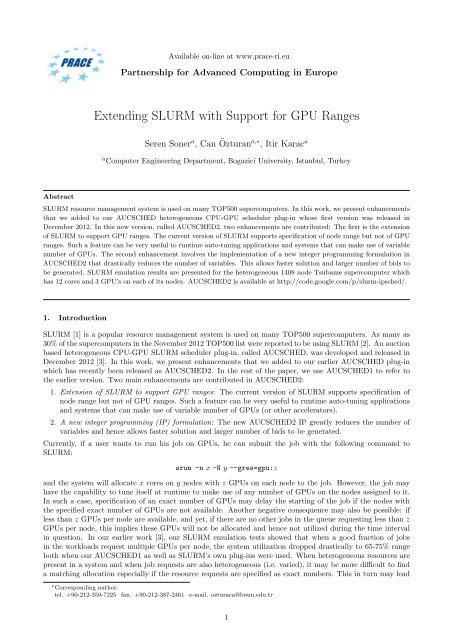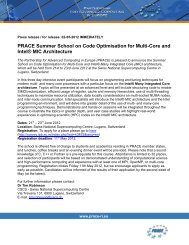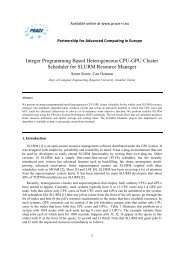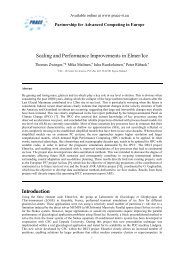Extending SLURM with Support for GPU Ranges - prace
Extending SLURM with Support for GPU Ranges - prace
Extending SLURM with Support for GPU Ranges - prace
Create successful ePaper yourself
Turn your PDF publications into a flip-book with our unique Google optimized e-Paper software.
ensures that the number of <strong>GPU</strong>s allocated to jobs are available on each node. U in is a boolean parameter, andis set to 1 in the bid generation phase if T in is positive, 0 otherwise.In this new <strong>for</strong>mulation, the only type of variable is b i , and hence, the total number of variables is |B|.The number of constraints is also reduced to |J| + 2|N|. When compared <strong>with</strong> those in AUCSCHED1, thesenumbers are greatly reduced enabling us to increase the number of bids in the bid generation phase. This inturn helps us to find better solutions.3. <strong>SLURM</strong> ImplementationAUCSCHED2 is implemented in a very similar fashion as AUCSCHED1. Hence, the whitepaper [3] can beconsulted <strong>for</strong> implementation details regarding preference value calculation, nodeset generation, bid generationand general working logic of AUCSCHED1. AUCSCHED2 is implemented as a scheduler plug-in along <strong>with</strong>resource selection plug-in ipconsres ( which is a variation of <strong>SLURM</strong>’s own cons res plug-in). Here, we justpresent AUCSCHED2 specific details.In AUCSCHED2, we have modified the options processing files <strong>for</strong> sbatch, srun, and salloc; which are variousjob submission commands used in <strong>SLURM</strong>. We have also modified the gres.c file in order to parse the requests<strong>for</strong> a range of <strong>GPU</strong>s. In the original <strong>SLURM</strong> implementation, the gres.c file parses the string gpu:z in thesubmission srun -n x --gres=gpu:z. We extend this capability by allowing the user to submit the job bysrun -n x --gres=gpu:z min − z max , which allows the job to request at least z min , at most z max <strong>GPU</strong>s pernode. This submission is still backwards compatible; submitting a job using srun -n x --gres=gpu:z will stillwork as in the original <strong>SLURM</strong> implementation.When a job is submitted <strong>with</strong> the srun -n x -N y --gres=gpu:z min − z max option, the bid generator willtry to bid on nodesets which have• at least x cores on y nodes• at least z min <strong>GPU</strong>s on each node.Several bids will be generated <strong>for</strong> the same job, but the bids may vary in the number of <strong>GPU</strong>s requested.There<strong>for</strong>e, to distinguish between different bids, we have modified our preference value calculation slightly toincrease the preference value of bids which request more <strong>GPU</strong>s. It should be noted that preference value onlyaffects the selection between bids of the same job.4. Workloads and TestsIn order to test our AUCSCHED2 plug-in, we conduct <strong>SLURM</strong> emulation tests. In emulation tests, jobs aresubmitted to an actual <strong>SLURM</strong> system just like in a real life <strong>SLURM</strong> usage; the only difference being that thejobs do not carry out any real computation or communication, but rather they just sleep. Such an approach ismore advantageous than testing by simulation since it allows us to test the actual <strong>SLURM</strong> system rather thanan abstraction of it. The tests are conducted on a local cluster system <strong>with</strong> 9 nodes <strong>with</strong> each node havingtwo Intel X5670 6-core 3.20 Ghz CPU’s and 48 GB’s of memory. <strong>SLURM</strong> is compiled <strong>with</strong> the enable-frontendmode, which enables one slurmd daemon to virtually configure all of the 1408 nodes in a supercomputer systemthat we emulate. The 1408 node system that we emulate is Japan’s Tsubame [5] system which has 12 cores and3 NVIDIA M2090 <strong>GPU</strong>’s on each of its nodes.We design a workload that takes into consideration the types of jobs that can be submitted to <strong>SLURM</strong>.There are seven types of jobs <strong>with</strong> each type making a different resource request as described below. Whentesting <strong>SLURM</strong>/Backfill, we use type A,B,C,D,E jobs. When testing AUCSCHED2 <strong>with</strong>out <strong>GPU</strong> ranges, weuse A,B,C,D,E type jobs. AUCSCHED2 that offers <strong>GPU</strong> ranges support is tested by using A,B,C’,D’,E typejobs. The probability of each job type in the workload is taken as equal.While generating the workloads, <strong>for</strong> job types C’ and D’, we assume that the execution time of each job isinversely related to the number of <strong>GPU</strong>s allocated to that job. Our motivation in using this assumption is that,such jobs <strong>with</strong> <strong>GPU</strong> ranges linearly scale their per<strong>for</strong>mance <strong>with</strong> the number of <strong>GPU</strong>s allocated on a node.Whereas this assumption can be questioned, we believe it is reasonable. Since on a node, there are a few <strong>GPU</strong>cards and if there is too much overhead <strong>with</strong> the use of variable number of <strong>GPU</strong>s on a node, the user might aswell use a specific (exact) number of <strong>GPU</strong>s on a node that gives the best per<strong>for</strong>mance and not submit the job<strong>with</strong> <strong>GPU</strong> ranges. Given the execution time t when the minimum number of <strong>GPU</strong>s is used, the execution timein AUCSCHED2 is calculated as follows:t ′ = t ·minimum no. of GP Us requestedno. of allocated GP UsFor example, suppose a job of type C’ takes 150 seconds when running <strong>with</strong> 1 <strong>GPU</strong> on each node and itrequests at least 1 and at most 3 <strong>GPU</strong>s on each node. If the job is allocated 2 <strong>GPU</strong>s, the execution time ofthat job will be taken as 75 seconds.(5)3
Table 2: Job types in the workloadJobType Description <strong>SLURM</strong> job submissionA only x cores srun -n xB x cores on y nodes srun -n x -N yC x cores on y nodes, 1 <strong>GPU</strong> on each node srun -n x -N y --gres=gpu:1C’ x cores on y nodes, 1 to 3 <strong>GPU</strong>s on each node srun -n x -N y --gres=gpu:1-3D x cores on y nodes, 2 <strong>GPU</strong>s on each node srun -n x -N y --gres=gpu:2D’ x cores on y nodes, 2 to 3 <strong>GPU</strong>s on each node srun -n x -N y --gres=gpu:2-3E x cores on y nodes, 3 <strong>GPU</strong>s on each node srun -n x -N y --gres=gpu:3We also have a parameter that sets the ratio of jobs that request contiguous allocation in the workload. ForNC workloads, none of the jobs requests contiguous resource allocation. For HC workloads, approximately halfof the jobs request contiguous resource allocation. For FC workloads, all of the jobs request contiguous resourceallocation. We have generated two workloads of different lengths in order to test the scheduler’s per<strong>for</strong>mancemore extensively. Workloads 1 and 2 have a mean theoretical runtime of 5 and 10 hours, respectively. Thenumber of jobs in the workloads are 350 and 700, <strong>for</strong> workloads 1 and 2, respectively.In Table 3, we report the theoretical run time, average run time, CPU utilization, <strong>GPU</strong> utilization, averagewaiting time, average fragmentation of each job in the workload, <strong>for</strong> <strong>SLURM</strong>’s Backfill and AUCSCHED2<strong>with</strong>out jobs having <strong>GPU</strong> ranges job and AUCSCHED2 <strong>with</strong> jobs having gpu ranges. We note that every testhas been per<strong>for</strong>med 27 times, and the resulting values are the average over all workloads of the same type. Thedefinitions of reported results are as follows:• CPU Utilization: The ratio of the theoretical run-time to the observed run-time taken by the test (workload).Run-time is the time it takes to complete all the jobs in a workload. Theoretical run-time is taken tobe the summation of duration of each job times its requested core count, all divided by the total number ofcores. Note that this definition of theoretical run-time we use is only a lower bound ; it is not the optimalvalue. Computation of the optimal schedule and hence the optimal run-time value is an NP-hard problem.• <strong>GPU</strong> Utilization: The ratio of the total allocated <strong>GPU</strong> time to the total available <strong>GPU</strong> time. The available<strong>GPU</strong> time is calculated by multiplying the run-time taken by the test, the number of <strong>GPU</strong>s at each nodeand the number of nodes. The allocated <strong>GPU</strong> time is calculated by summing up the total number of <strong>GPU</strong>sallocated at each time at any node.• Waiting time: Time from job submission until scheduling.• Fragmentation: Number of contiguous node blocks allocated to a job.5. Discussion and ConclusionsWhen comparing <strong>SLURM</strong>’s implementation <strong>with</strong> our the <strong>GPU</strong> ranges implementation, the tests per<strong>for</strong>med onthe synthetically generated workloads show that <strong>GPU</strong> ranges feature can result in a 2-6% higher CPU utilizationwhen multiple <strong>GPU</strong>s are used. Average fragmentation and runtimes are also slightly lower or equal in all thetest cases. We also observe a 1-5% increase in the <strong>GPU</strong> utilizations in our <strong>GPU</strong> ranges implementation. Themajority of average waiting times are also slightly lower. Hence, our tests provide convincing evidence that the<strong>GPU</strong> ranges feature can be useful to users and to supercomputer centers.As identified in [3], low utilizations are obtained when there exists a sizeable fraction of jobs that use multiple<strong>GPU</strong> cards in the workload. As we observed in this work, <strong>GPU</strong> ranges can lessen the effects of this, albeit, onlyslightly. Currently, our <strong>GPU</strong> ranges implementation allocates the same number of <strong>GPU</strong>s on all the nodes. Forexample, if a range of 1-3 <strong>GPU</strong>s is given, the number of <strong>GPU</strong>s on all the nodes in a single bid is the same. (i.e.they can be 1 <strong>GPU</strong> per node or they can be 2 <strong>GPU</strong>s on all nodes requested, etc). The R gpuj term in constraint4 in the IP <strong>for</strong>mulation implements this. This is the most intuitive way to implement this, since, if allocatednodes can have different numbers of <strong>GPU</strong>s (while still being in the same range), load balancing issues arise.On the other hand, if the application can tune load balancing of its processes when different numbers of <strong>GPU</strong>sare allocated on the nodes then we can possibly expect such flexible <strong>GPU</strong> range implementations to lead tohigher utilizations. In the future, we may implement this additional flexibility, perhaps, by making use of ourPMAXFLOW maximum flow solver[6].Our new IP <strong>for</strong>mulation, besides having the advantage of reduced number of variables, can also help usto implement other heuristics: For example, linear programming (LP) relaxed heuristics. As we head towards4
















